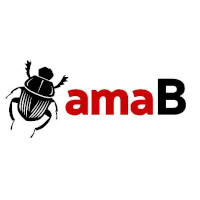▶️ The post The #Laundry: Shadow Banks, part one – phantom gold appeared first on amaBhungane.
Recap: In Parts One and Two of this series we saw how illicit gold seemingly made its way through a system winding all the way from the Reserve Bank’s Krugerrand subsidiary through a coin-dealing pastor to exporting refineries, allegedly in service of a huge tax scam. The next stop is Dubai and, the evidence suggests, a vast money laundering network with one mission in particular: sending huge sums to an entity called Aulion Global Trading – this time seemingly involving entirely fictitious gold.
When recently retired Chief Justice Raymond Zondo presided over the sprawling Commission of Inquiry into Allegations of State Capture, a brief and easily overlooked appearance was made by one Kalandra Viljoen, nominal owner and manager of Asset Movement Financial Services (AMFS).
This “cash-in-transit” company, which did a suspiciously large amount of business simply making electronic payments between third parties, had been the conduit for about R4-million leached out of airline SA Express via a company named Koreneka.
R4-million was a drop in the ocean of state capture and, as we saw in previous instalments, equally insignificant in the world of AMFS.
Zondo was, however, moved to add a recommendation to his final report that the South African Reserve Bank (SARB) should look into the company.
“The question that needs to be answered is whether AMFS was providing general money laundering facilities to those who wished to have their proceeds converted to cash without the necessary checks required from the formal banking system,” he stated.
If only he knew.
For a sense of scale, the bank statements we have for AMFS reflect flows of roughly R33-billion through the company between its creation in early 2015 and early 2019. Much of that was the revenue of a small set of gold refineries which, as we saw in previous instalments, was at times destined for questionable recipients.
In particular, we have seen evidence suggesting that at least R5-billion of this consisted of payments to Krugerrand dealer African Medallion Group, seemingly originating in large part from the micro-refinery The Gold Kid, which used AMFS to make these payments (as described in Part Two).
Some of AMFS’s colossal flows also seemingly involved small once-off deals like the Koreneka one above.
Its bank statements are littered with incidents: for instance, what looks like R6-million received from fugitive pastor Shepard Bushiri in December 2017, which seems to have been destined for cash delivery.

Scattered throughout the books, as well as across extensive documents from both inside and outside AMFS, we have found what appear to be other huge clandestine operations.
After Krugerrand buying, the single largest coherent “project” that can be discerned is the channelling, between 2016 and 2019, of billions of rands to Aulion Global Trading in Dubai, as well as a few related entities in Dubai and Hong Kong, using several successive avenues wherein AMFS played a key role.
We can now reveal, based on the information available to us, that this “operation” involved over R5-billion leaving South Africa for Dubai under false pretences over the four years, although this is very likely an underestimation due to the limitations of our data.
Alongside AMFS, this story involves a wider cast of characters, byzantine financial arrangements and, our information suggests, at least a billion rands’ worth of non-existent gold “traded” between South Africa and Dubai.
Birth of the “gold lion”
Aulion Global Trading was registered in October 2015 by the owners of The Gold Kid –Andries Greyvensteyn and sanctioned money mover Howard “Howie” Baker’s notorious gold refinery.
AMFS was also set up in 2015, again with the involvement of Greyvensteyn, who recruited the aforementioned Kalandra Viljoen from another cash-in-transit company named Rustic Stone Trading 10, which operated in the gold sector.
She was to be the sole shareholder in AMFS, which operated out of The Gold Kid’s premises in Nigel.
The Gold Kid immediately became AMFS’s main client, even though the latter would go on to service a wider array of similar gold operations. Many of these operations have been investigated by SARS for alleged tax fraud.
The three companies – The Gold Kid, Aulion and AMFS – are inextricably bound together through the involvement of Greyvensteyn and Howie Baker.
And, as we will show, Aulion came to be central to an even larger network.
Both amaBhungane and other media publications have reported on parts of the Aulion gold network and its alleged receipt of the proceeds of alleged illicit cigarette sales by the Gold Leaf Tobacco Corporation, which is controlled by Simon Rudland and partner Ebrahim Adamjee.
Gold Leaf has denied wrongdoing and is fighting a 2022 preservation order obtained by SARS against the company and its directors.
New evidence, however, gives significant insight into the true scale of the Aulion endeavour, including what went on behind the scenes and who else was involved.
Among other things, we can show how many other entities locally and abroad channelled funds to Aulion. For this, at least one other “shadow bank” in the mould of AMFS was used.
First, however, we will explore what looks like a daring scheme to position Aulion at one end of a colossal circular money laundering system involving the apparent faking of gold trading.
Johannesburg to Dubai and back
AmaBhungane has obtained no less than 5 378 emailed instructions sent by Howie Baker to AMFS’ Kalandra Viljoen between September 2015 and 2017, including instructions to pay the controversial Krugerrand dealer we reported on in [Part Two] of this series.
Of specific interest here is a subset of 134 of these instructions, each of which direct AMFS’s Viljoen to make payments to a FNB account with the reference “Sasfin payment”.
In each of these cases, Veronica Schubach, then manager of The Gold Kid, was copied.
Coupled with evidence drawn from bank statements, this indicates that the money for “Sasfin payments”, at least on paper, came from Greyvensteyn’s refinery, The Gold Kid.
Let’s illustrate this by examining the transaction chain over the course of a single day. We begin with an email sent by Baker on 20 October 2016:

Tracing the ensuing bank statements clearly demonstrates how the “Sasfin payment” reached its actual intended beneficiary.
The trail starts with The Gold Kid, AMFS’s main client.
In The Gold Kid account, we see four outgoing payments for the day totalling just under R26-million. We then see these payments – recognizable due to matching reference numbers – arrive in AMFS’s account.

At AMFS, the requested amount of R17 450 673 is paid out to Sasfin, as directed in Baker’s email. Another payment of R9-million is also made; this does not concern us here but explains why a total of R26-million had originally been transferred.

Now we move to Sasfin itself, or rather its transaction account held at FNB – the account Baker gave in his email. At the time, Sasfin was not a transactional bank but instead held accounts at all the other major banks. Sasfin received clients’ money via these banks before paying it abroad.
At FNB we see the R17 450 673 payment from AMFS arriving and on the same day being paid forward to Sasfin’s account at Nedbank, mixed up with some other small amounts received on the day.

This payment just reflects Sasfin’s practice of settling outbound payments every day by pooling the amounts paid into different accounts in one place.
At Nedbank we again see this amount arriving and, later in the day, the exact amount requested by Baker gets paid offshore to Aulion with the reference “Gold Leaf Tobacco Corp” – Rudland and Adamjee’s cigarette company, suggesting either Gold Leaf was involved in the scheme or that the money was ultimately theirs.

In reply to amaBhungane’s questions, Gold Leaf’s lawyer Raees Saint denied this inference.
Saint argued that “at the core of your inquiry is the assumption that funds flowing through various entities must somehow be connected to our client by virtue of certain payment references. There exists no evidence to suggest that these transactions involve or are funded by our client and any assertion of this nature is nothing more than a flagrant lie. Reference codes in bank statements or proof of payments are not the criteria in determining the true origin, ownership or purpose of funds…”
Regardless, we can see examples of this transaction train repeated at least 134 times with various supplier references (including but not limited to Gold Leaf), with the total value adding up to R2.7-billion.
These transactions were justified by invoices for alleged imports generated by a broker named SALT Asset Management, which belonged to two associates of Baker and Greyvensteyn: Mohammed Khan and Soheil Jiwani.
Many of the invoices generated by SALT are obvious fakes; in some instances, banking details for Aulion are simply pasted onto legitimate invoices from other companies.
But this is not the end of the story.
Ghost gold
Sending money offshore under false pretences is one thing. These payments seemingly went much further, with at least a very significant portion of them entering a novel circular system which at first glance makes no sense at all.
Based on the evidence available, it appears that much of the money Baker ordered to be paid to Aulion via Sasfin was for gold that existed only on paper.
Let us return to the R17 450 673 payment we followed from The Gold Kid to Sasfin’s account at Nedbank, from where it was paid offshore.
In Aulion’s bank statements this amount arrives with the same reference used at Sasfin – Gold Leaf Tobacco Corporation.
Another large payment of just over R20-million arrived at the same time. We have also traced this payment back to Nedbank and a payment bearing Gold Leaf Tobacco Corporation as a reference, although we have no record of who owns the account that made this payment.
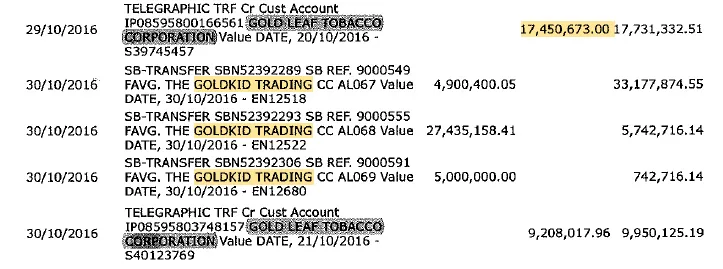
Here is where things get strange.
The Aulion account is quickly drained by outward payments, all marked “Gold Kid”, i.e., the very source of the money to begin with.
All these payments from Dubai back to South Africa are visible in one of the accounts held in South Africa by The Gold Kid.
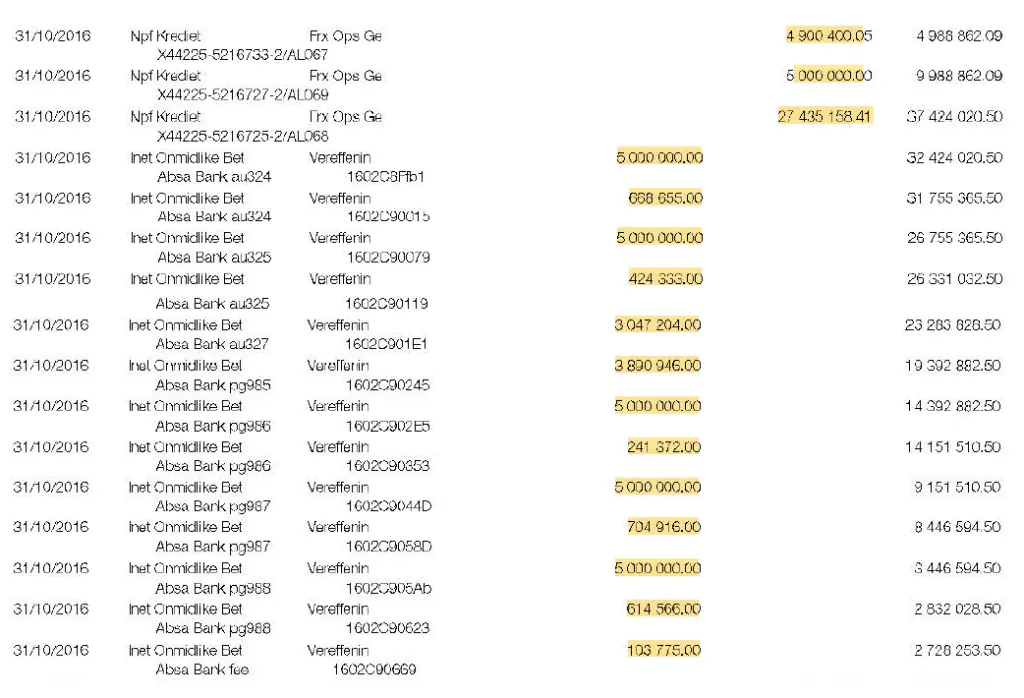
And then the money is immediately paid onwards again.
We can trace these payments back to AMFS, where the money arrives just in time for another instruction from Baker to pay it to Sasfin in order to start the whole process over again.
And here is where the true nature of the scheme seems to lie: an entirely circular flow of money from The Gold Kid to Aulion and from Aulion back to The Gold Kid. The question is why engage in such a seemingly pointless exercise?
A major clue lies in the payment references Aulion used to pay money back to The Gold Kid. Each of these are given as “AL” followed by sequential numbers. In the excerpt from Aulion’s account above we saw payments marked AL67 through to AL69.
These are also used in the statements of The Gold Kid when it receives the money.
Scouring The Gold Kid’s statements reveals many more “AL” payments. commencing no later than January 2016, shortly after Aulion was created.
Looking at 2016 as a whole, we see at least R1.17-billion arrive in The Gold Kid’s account through these “AL” payments.

Fake gold for real VAT?
SARS has conducted a far-reaching audit of The Gold Kid’s business, as we reported in a previous instalment.
From the details of this audit, it seems that payments to Sasfin (and ultimately offshore to Aulion) were disguised as payments to South African suppliers of scrap gold. If our interpretation is correct, The Gold Kid was seemingly pretending to buy gold in addition to its real gold business.
This interpretation is supported by the fact that the VAT invoices The Gold Kid used when it allegedly paid its scrap gold suppliers in fact match payments made to Sasfin or other entities that do not appear to lead back to the ‘suppliers’.
For example, on the day the payments above were being chanelled to Aulion, The Gold Kid declared it was paying a supposed supplier called Bhekusifiso Scrap. This is reflected in so-called tax type reports it produced for SARS in which it show the supposed payments with the VAT supposedly paid.

Thus far we have seen no actual financial records of the claimed payments being made to The Gold Kid’s supposed scrap gold suppliers, although Greyvensteyn has vowed to produce this evidence at some point in an ongoing court battle with SARS, as we reported on in a previous instalment.
At the other end of the equation The Gold Kid’s documentation of sales perused by SARS showed it making sales to Aulion of about R1.1-billion – pretty much the same amount of money we saw going through the “rinse cycle” between South Africa and Dubai.
In other words, what we see is The Gold Kid allegedly sending money to Aulion under the guise of buying gold domestically.
This money then comes straight back to The Gold Kid while it declares, in the documentation perused by SARS, that it is exporting gold to Aulion.
The pattern suggests that not only the purchases of gold but also the sale of gold were, at least some of the time, fake. It seems that no gold ever really changed hands, certainly not in the quantities that would match the amounts of money involved.
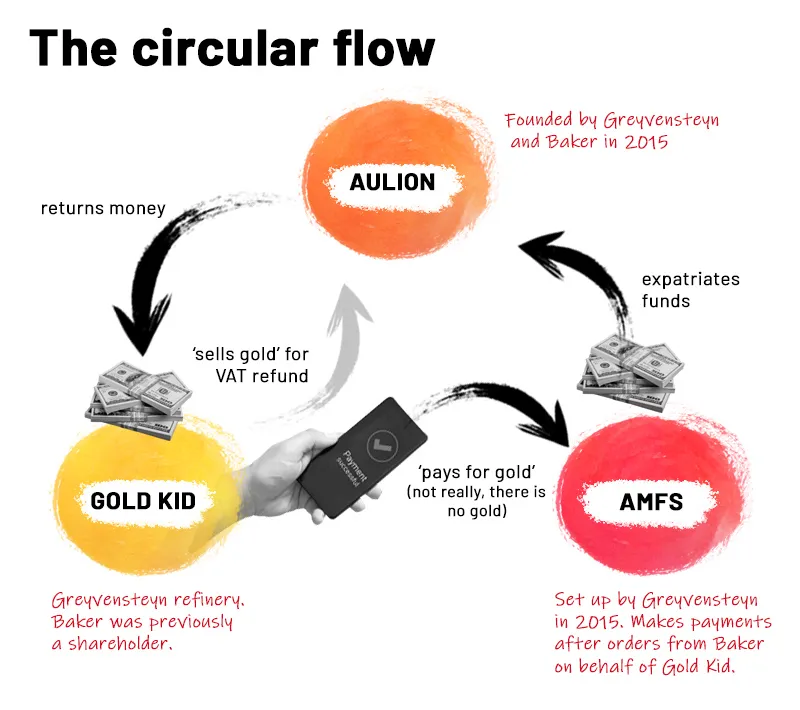
The whole point, again, would be the claiming of VAT refunds for the fictitious exports (which are zero-rated for VAT), which would have been based on (again, allegedly fictitious) purchases of gold that would have come with VAT.
This is the basic system that was outlined in Part Two of this series. Essentially, this earlier iteration of the alleged scheme appears to operate by generating payments for gold that doesn’t exist.
This would have the same effect as the better-known version of the scheme which involves using tax-free gold like Krugerrands (also zero rated) disguised as “scrap” to generate bogus tax refunds, a practice which has cost the fiscus billions.
While the documents we have suggest that the system we described above was in full swing in 2016, it becomes harder to interpret the nature of payments made via Sasfin in 2017, not least because The Gold Kid switched banks from ABSA to Standard Bank and the “AL” references disappeared from its statements.
New systems, new partners
From 2017 through to 2019 the configuration of The Gold Kid, AMFS and Aulion started shifting, with Aulion, the Dubai company, obtaining mountains of funding through new channels and, as far as we can tell, spending a large amount of it on real gold.
Aulion did in fact buy gold while The Gold Kid did sell it. As we showed in a previous instalment, a lot of this was complicated by the introduction of Krugerrands into the system, but nonetheless, real gold sales took place.
The Gold Kid sold practically all its gold to Rappa Resources, one of few export-orientated refineries. Rappa denies any knowledge of whatever The Gold Kid may have been up to and no evidence we have suggests otherwise.
Aulion, in turn, made all its gold purchases from Rappa.
It was not the refinery’s major client, but its purchases were nonetheless significant.
Using the limited data at our disposal we have very roughly calculated the scale of Aulion’s purchases from Rappa.
While we estimate the figure to have almost reached the R1-billion mark in 2017, Rappa CEO Gary Bickerton told us that the real figure is “less than R1-billion”, albeit without volunteering how much less.
From our rough calculations, it can be seen that Aulion’s purchases from Rappa escalated massively in 2018 and 2019.
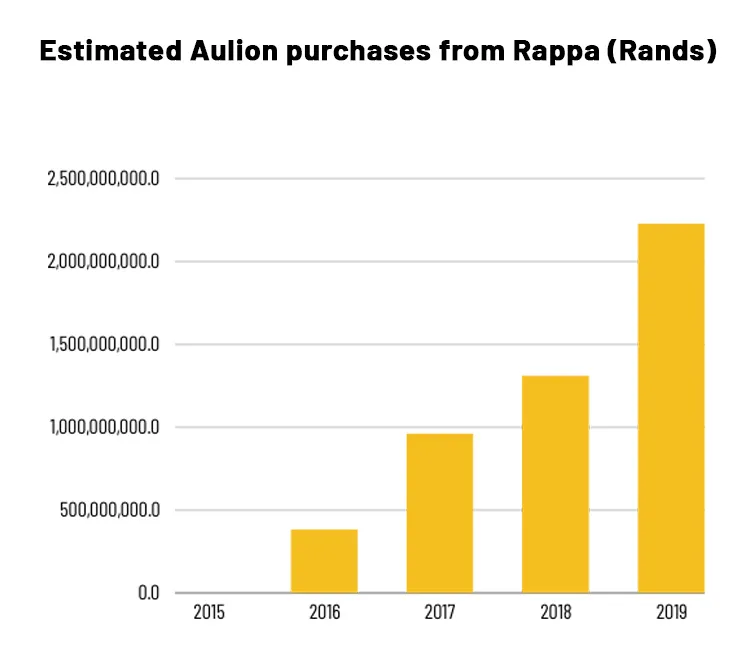
But how was Aulion – and by extension all this gold buying – being funded?
The payments being made to Aulion via Sasfin came to an abrupt end in July 2017 following an internal decision by the bank to terminate Gold Leaf as a customer.
Our documentation for this period contains gaps, but we can pick up the trail of “Project Aulion” again in early 2018 when major new characters began funnelling money to this Dubai company.
Beyond Sasfin
AmaBhungane previously revealed a massive laundering operation that emerged during 2018 and 2019 using the now-liquidated Habib Overseas Bank [link].
Early in 2018, an account was opened at Habib by a company named PKSA Finance. This company belonged to Mohammed Khan and partner Sohail Jiwani, the aforementioned associates of Baker who gained notoriety after Khan featured prominently in an Al Jazeera documentary on a regional “Gold Mafia” last year.
Over the course of 2018, PKSA received nearly R1.4-billion and paid most of it straight out again – almost entirely to Aulion.
At the same time, another entity associated with Khan, Ovenbird, opened an account at Habib. This account received R370-million in less than two months and again paid almost all of it out to Aulion.
In 2019 a new front named Actinic was created and, as we reported, opened several accounts at different banks, accounts from which it promptly began sending money to Aulion. From a SARS audit of one of Howie Baker’s companies we know that Actinic was also being funded by him.
Combined with the earlier operation through Sasfin, this brings payments to Aulion to the region of R4.5-billion over three years – this just from entities we know about.
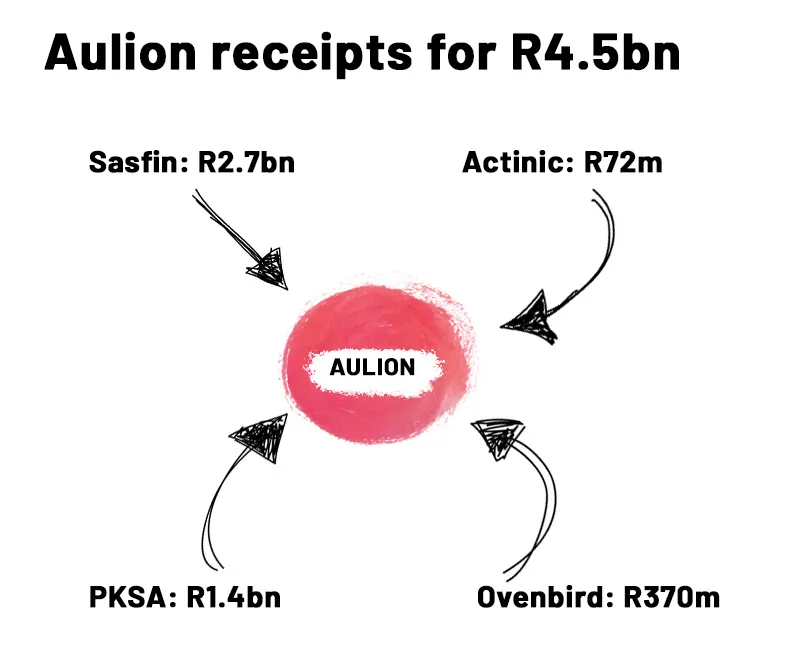
As before, a lot of the money from these new entities came from AMFS and, by extension, The Gold Kid.
But a lot came from elsewhere.
One particularly notable source was another shadow bank in the mould of AMFS: cash-in-transit company RENS Kontant in Transito – the subject of a coming instalment. Also notable was another refinery named Metal Enhancors.
RENS leads us beyond gold to the door of alleged tobacco smugglers associated not only with Howie Baker but also the man widely considered to be the power behind the scenes – cigarette mogul Simon Rudland.
Like AMFS, RENS was seemingly just the conduit.
The customer: Baypass
According to records we have obtained, including bank statements, payments coming from RENS were all done on behalf of a company named Baypass Logistics.
Baypass had also earlier, in 2017, channelled R324-million into AMFS. This money was, as far as we can establish, used for the purchase of Krugerrands at the behest of Howie Baker.
There is an immediate red flag hovering over this multi-million rand company: the sole director is an individual whose last known employment was at a bottle store and who is simultaneously the sole director of seven different “logistics” companies.
Our efforts to identify the true hand behind Baypass leads straight to the illicit tobacco sector, specifically the trade between Zimbabwe and South Africa.
In RENS’s internal client book, the contact person for Baypass is given as simply “JC”, with a Zimbabwean phone number that doesn’t work and an email address no one responds to.
We did however find a 2018 email between “JC” and a RENS employee:
Morning JC
Hope all is well. Can we URGENTLY get a response on this letter.
Kind Regards,
Attached to this email was a letter signed by RENS owner Christo Janse van Rensburg requesting that “JC” provide a formal letter on a Baypass letterhead listing the services RENS is supposed to render. This should include collecting cash and making electronic payments to Baypass clients, said Janse van Rensburg.
Crucially, however, the letter ends with a note:
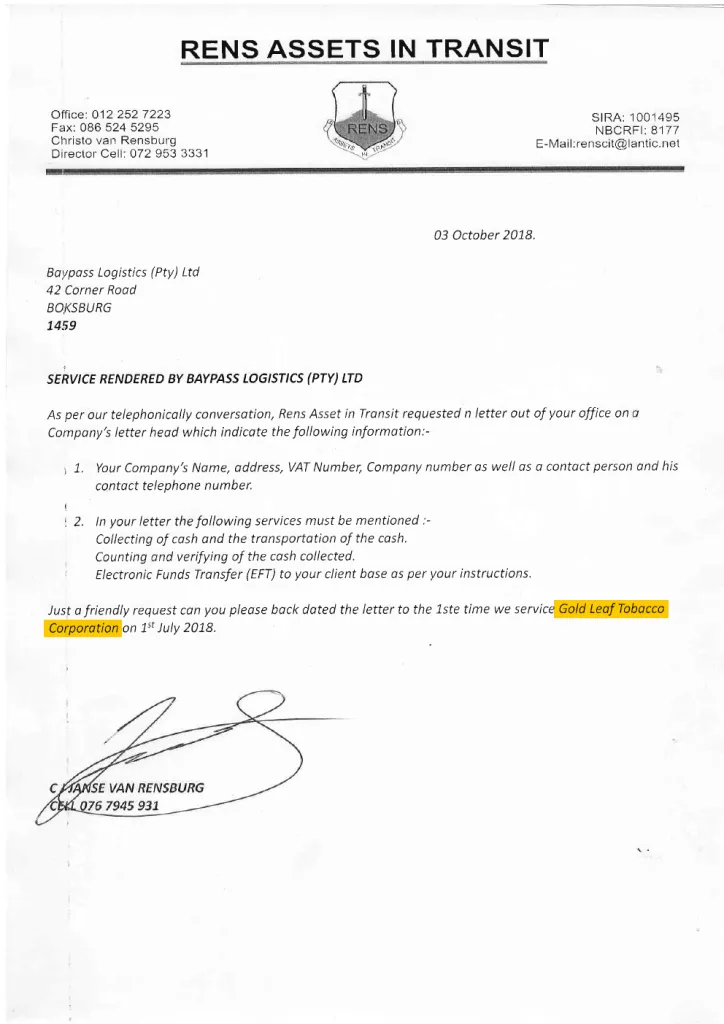
“Just a friendly request can you please back date the letter to the 1st time we serviced Gold Leaf Tobacco Corporation on 1st July 2018.”
Readers will recall that Gold Leaf is the tobacco company owned by Rudland and partner Ebrahim Adamjee.
The evidence thus raises the possibility that Baypass, after already moving hundreds of millions for Rudland associate Baker, became Gold Leaf’s conduit for paying money to South African recipients via RENS.
Gold Leaf did not respond to questions about Baypass, but their lawyer’s comments about references to Gold Leaf by third parties not being evidence of his client’s involvement would apply here.
Baypass, however, also has another link to the tobacco sector.
The shelf company vendor who registered and then sold the Baypass registration provided us with an email address for the buyer – one identifiably belonging to a Roy Muleya.
This would appear to be the same Roy Muleya who made headlines in 2021 when SARS accused his company Verbena Freight and Logistics Management of owing an astonishing R19-billion in custom duties related to alleged tobacco smuggling from Zimbabwe.
It is possible that there are two individuals named “Roy Muleya” involved in large-scale illicit cross-border activities, but additional circumstantial evidence reinforces that the buyer of Baypass and the alleged tobacco smuggler are one and the same.
The SARS case against Muleya was heavily redacted in court, but mention was made of him using Verbena and seven other companies to, on paper, import tobacco. This happens to neatly fit the existence of the seven suspicious companies with the bottle store employee as their unlikely director.
The above suggests that Baypass was associated with Gold Leaf, which makes its larger list of apparent clients all the more interesting.
Watch out for our next instalment where we delve into this mysterious client of RENS, as well as the other damning clients hidden in its books.

